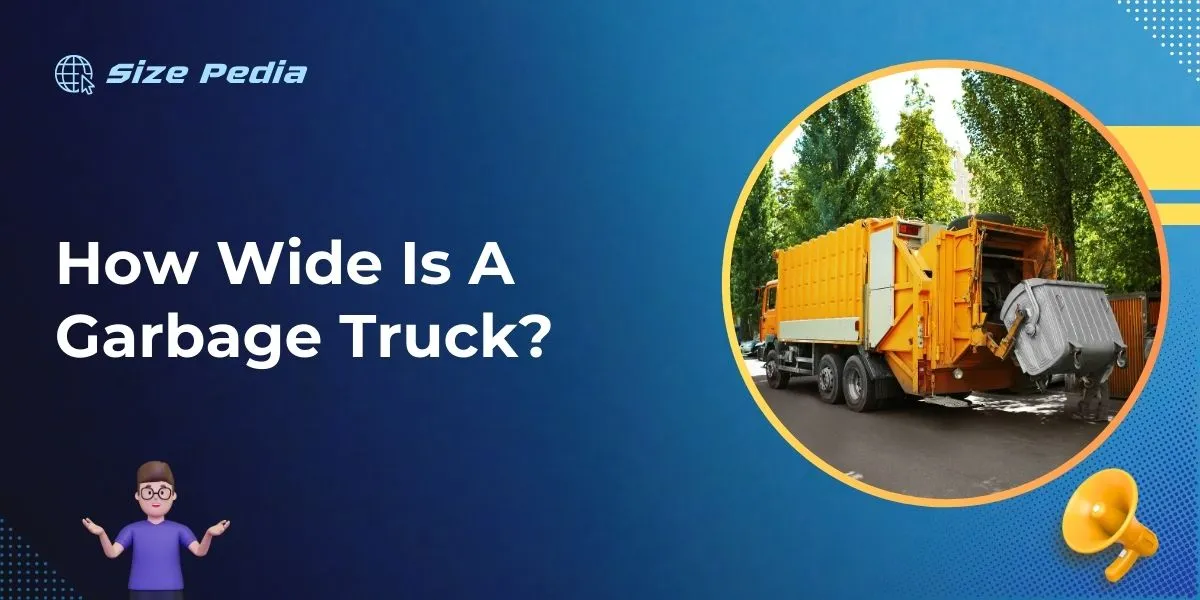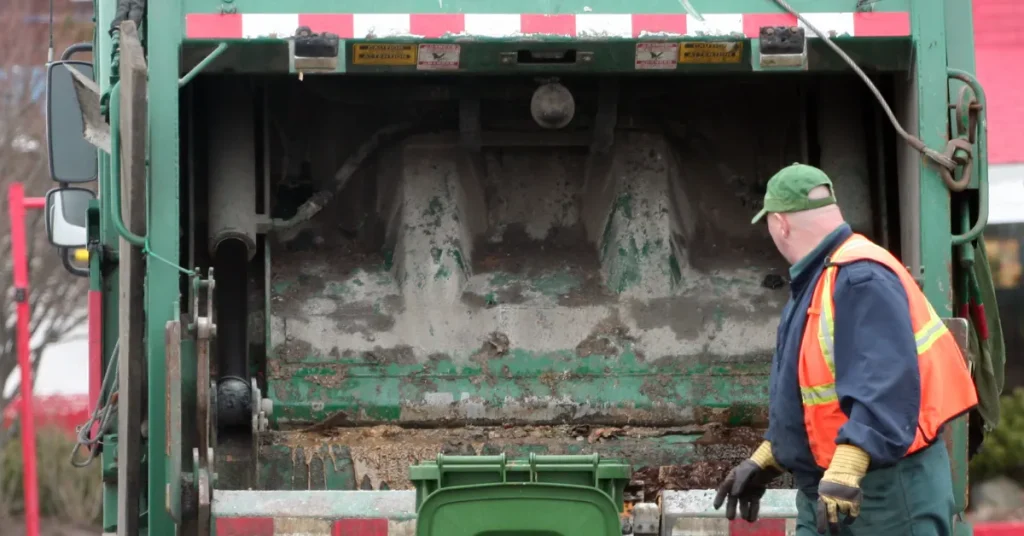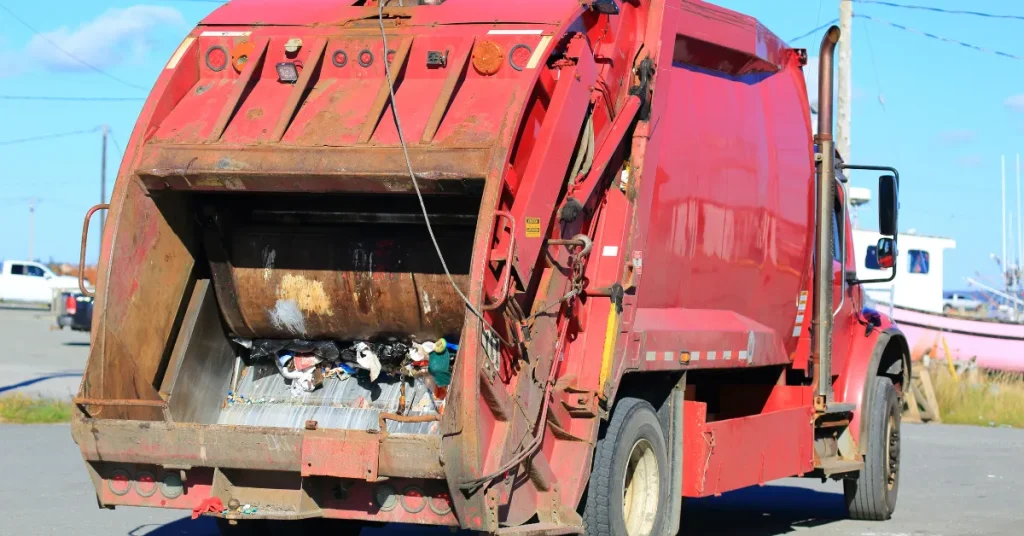A standard garbage truck is typically around 8 to 9 feet wide. On average, this width allows for smooth operation in urban environments.
Garbage trucks play a crucial role in waste management, tasked with the responsibility of collecting trash from residential and commercial areas to maintain cleanliness and sanitation.
Their design is optimized to navigate through various street sizes, with a width that enables them to fit comfortably within standard driving lanes.
This ensures they can access bins and dumpsters without obstructing traffic. The width of garbage trucks is a fundamental aspect of their design, considering the need to balance operational efficiency with safety and regulatory compliance.
As cities grow and evolve, the design of garbage trucks adapts to meet these challenges, ensuring they can continue to operate effectively within the confines of urban infrastructure.

Dimensions Matter In Waste Management
Dimensions Matter in Waste Management – a phrase that resonates across city streets to suburban alleys. A garbage truck’s size directly influences its maneuverability, accessibility, and efficiency.
As cities grow denser and space becomes premium, each inch on these waste-collecting monsters counts. Knowing the exact width of these vehicles is crucial for urban planning, route optimization, and reducing environmental impact.
The Importance Of Knowing Garbage Truck Width
The width of a garbage truck is not just a number. It represents the difference between a smooth operation and logistical headaches. Tight streets and limited space pose challenges.
Wide vehicles struggle. Waste management companies must know these dimensions. They ensure trucks pass through neighborhoods without damaging property or vehicles.
Average Widths Across Different Models
Different garbage truck models have varying widths. Most standard trucks measure around 8 to 9 feet wide. When mirrors are included, the total width may reach up to 11 feet. Below is an illustrative table listing average widths for common garbage truck models:
| Model Type | Average Width (Feet) | Width with Mirrors (Feet) |
| Rear Loader | 8.5 | 10.5 |
| Front Loader | 8.5 | 11 |
| Side Loader | 8 | 10 |
| Roll-Off | 8 | 10 |
Note that specific models may vary based on manufacturer and customization. Make sure to refer to the manufacturer’s specifications for the most accurate measurements.
Types Of Garbage Trucks And Their Widths
Understanding the size of different garbage trucks helps when planning waste management logistics. Various garbage trucks have different widths to fit the jobs they perform.
Front Loaders: For Commercial Use
Front loaders dominate commercial waste removal tasks. They access waste containers from the front.
Standard widths for front loaders range between 8 and 9 feet, not including their mirrors. Their design makes them ideal for maneuvering in tight commercial spaces. The arm mechanism adds width when operating, requiring extra clearance.
Rear Loaders: For Residential Areas
In residential zones, rear loaders are common. These trucks collect trash directly from the back.
- Rear loaders average around 8 to 9 feet wide.
- They need space for their backside to open during garbage collection.
Side Loaders: Automating Collection
Side loaders make trash collection faster. They lift bins from the side automatically.
Typically, sideloaders are about 8 to 9 feet wide. Some may need extra space for their automated arms.
Roll-offs: Versatility In Size
Roll-offs carry large waste containers on their backs. They are the heavy lifters.
Widths vary from 8 feet for smaller models to over 9 feet for larger ones. They require a lot of space for the roll-off mechanism to operate.
| Type of Garbage Truck | Average Width |
| Front Loader | 8-9 feet |
| Rear Loader | 8-9 feet |
| Side Loader | 8-9 feet |
| Roll-Off | 8-9+ feet |
Factors Influencing Garbage Truck Width

Understanding the width of a garbage truck is key. Many factors affect how wide they are. Let’s dive into what influences garbage truck dimensions.
Design Elements Affecting Size
Different garbage trucks have varying sizes. This is due to their design features. Here are some key elements:
- Body type: Compact trucks are narrower. Full-size models need more space.
- Capacity: Bigger loads need wider bodies. This means larger trucks.
- Equipment: Side loaders require extra width for arms. Rear loaders might be slimmer.
These elements blend to define a truck’s overall width.
Regulatory Standards And Road Limitations
Laws restrict truck sizes. Roads also limit how wide trucks can be. Below are the standards they must meet:
| Regulation Type | Width Limitation |
| Federal Standards | Up to 102 inches without special permits. |
| State Laws | May vary, always check local requirements. |
| City Ordinances | Often stricter, based on street sizes. |
The combined effects of these rules shape truck width. This ensures safety and efficiency on the road.
Navigating The Streets: Challenges And Solutions
Garbage trucks are a vital part of our urban landscape, playing a crucial role in keeping our cities clean. Yet, their size can pose significant challenges in the congested streets and tight alleyways of bustling cities.
This section delves into how these essential vehicles manage to navigate through complex environments and what innovations have been made to enhance their maneuverability.
Adapting To Urban Environments
In the heart of the city, space is at a premium. Garbage trucks need to be agile and compact.
Many cities have narrow roads, which means standard-size garbage trucks may struggle to pass through. To overcome these challenges, truck designs have been modified.
- Shorter wheelbases make for tighter turns.
- Slimmer profiles allow access to restricted spaces.
- Cab-over-engine designs give drivers better visibility.
Technological Advancements For Better Maneuverability
Garbage trucks have evolved with technological innovations. These advancements help them to effortlessly weave through the urban maze.
| Technological Feature | Benefit |
| 360-degree cameras | Provides a bird’s-eye view for safe navigation |
| Sensors | Alert drivers to nearby obstacles |
| Electric powertrains | Offer smoother, quieter operation in residential areas |
Eco-friendly features also now play a big part in urban garbage collection. Electric and hybrid models not only reduce emissions but also trim down the operational noise.
This makes early morning trash collection less disruptive to residents. With each technological improvement, garbage trucks are becoming more efficient and less intrusive in our daily lives.
Beyond Width: Other Critical Garbage Truck Specifications
While the width of a garbage truck grabs attention, other dimensions play a vital role. Understanding these specs helps gauge a truck’s operation capabilities. Let’s dive into essential garbage truck specifications beyond width.
Capacity And Volume: The Loading Space
The capacity of a garbage truck is crucial. It determines how much waste it can handle.
- Front Loaders: Have large bins, perfect for commercial use.
- Rear Loaders: Are common in residential areas. They make frequent stops.
- Side Loaders: Offer automated arms, requiring less manpower.
Each type supports different volume needs.
Height And Length: Overall Dimensions
Garbage trucks must fit under bridges and through tunnels. They vary in height and length.
| Type | Height | Length |
| Compact | 10 feet | 20 feet |
| Standard | 11-12 feet | 25-30 feet |
Match the truck to the job setting.
Turning Radius: For Tight Corners
Turning radius affects navigation. Tight corners require a smaller turning radius. Urban areas often demand this feature.
Different models boast distinct turn capabilities. Choose based on route complexity.
Choosing The Right Garbage Truck For Your Needs

Understanding the width of a garbage truck is crucial when selecting the perfect model for waste management.
Garbage truck dimensions affect maneuverability and capacity. The right choice ensures your operations run smoothly and efficiently. Let’s dive into what to consider.
Assessing Local Infrastructure
Before investing in a garbage truck, assess your area’s infrastructure. Streets, alleys, and access points dictate the size of your truck. Tight spaces require narrower models. On the other hand, wider roads allow for larger options. Check the following:
- Street widths
- Turn radius capability
- Overhead clearance
- Loading dock specifications
Balancing Efficiency And Practicality
Garbage trucks should balance load capacity with local needs. A balance ensures efficient trash collection. Larger trucks carry more but struggle in narrow streets. Smaller trucks fit better but may need more trips. Consider these points:
| Truck Size | Efficiency | Practicality |
| Compact | High maneuverability | Best for tight spaces |
| Medium | Good balance | Adaptable to most areas |
| Large | Maximum capacity | Suitable for wide streets |
Match your truck size with your route specifics and waste volume. This ensures a smart investment for your sanitation requirements. Make a choice that marries efficiency with practicality.
FAQs About How Wide Is A Garbage Truck
How Wide Is A Front Load Garbage Truck?
A typical front load garbage truck is about 8 to 9 feet wide, excluding side mirrors.
What Is The Average Height Of A Garbage Truck?
The average height of a garbage truck is around 10 to 14 feet (3 to 4. 3 meters).
How Long Is A Garbage Truck In Feet?
A standard garbage truck measures about 20 to 25 feet in length.
How Much Can A Front Loader Garbage Truck Lift?
A front loader garbage truck typically can lift up to 8,000 pounds. This capacity allows it to handle large, commercial waste containers with ease.
Conclusion
Wrapping up, the width of a garbage truck is more than just a trivial detail. It guides city planning and influences waste management strategies. Typically stretching between 8 and 10 feet, these vehicles are built for efficiency.
Keeping our streets clean and communities thriving, the dimensions of these trucks are designed for optimal performance.
Remember, next time you see a garbage truck, its size is essential to its function.
Resources:
1. https://www.hayward-ca.gov/your-environment/garbage-and-recycling
